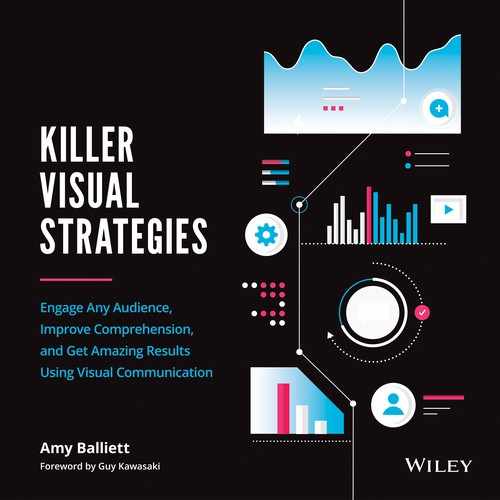HOW TO READ THIS BOOK
This book is not meant to be an academic beast of information about the scientific application of visual communication and storytelling. There are dozens of books out there that already fill that need. Instead, this book is actionable. It is written for all levels of understanding with the goal of being easy to digest so that you're empowered to take immediate action within your organization.
This book is broken into three parts, each building on the last without being dependent on it. This means you can start reading at any part of the book; that way, you can gather the information that you find most relevant to your immediate needs. Of course, if you choose to read it cover-to-cover, you'll gain an even more thorough understanding of the subject matter.
THE ACCIDENTAL AGENCY
To lay the foundation for this book, I begin with the story of how my company, Killer Visual Strategies, got started. This story offers a setting for the narrative that follows.
PART 1: VISUAL CONTENT IS KING
To prepare you for the lessons ahead, this section provides critical context that will be applied to the rules outlined in part 2 of this book. It includes a thorough overview of the environmental factors that have contributed to our present-day consumer demand for visual content by summarizing key moments in recent history that have shifted audience expectations.
Part 1 continues by delivering insights into key elements of audience psychology that inform visual communication today, along with some examples of the varying use cases for visual strategy. This section concludes by exploring the expectations and motivations of audiences today and how this impacts their perception of quality in visual media.
PART 2: 8 RULES OF VISUAL COMMUNICATION
The second part of this book is intended to be both a practical reference guide and a deeper dive into each topic, allowing for either continued reading or immediate application, depending on your needs.
Every chapter in part 2 explains a key rule in visual communication design. You can read these chapters in any order, and do not need to read them all the way through to learn how to apply each rule to your own visual content. Each chapter is broken into three distinct parts that can be read independently of one another or together, depending on how deep you want to delve into the topic. Those parts are as follows:
- Rule: Each chapter will open with a rule about visual communication followed by a thorough explanation of why the rule exists.
- Exercise: To best exemplify the rule and put it to the test, an exercise continues the chapter. These exercises do not require knowledge of design software, but from time to time will require you to be near a computer and utilize free online tools.
- Key Takeaways: To sum up the chapter, I'll share a number of conclusions. If you're short on time, start by reading the key takeaways, which provide concise steps that you can apply to your visual content immediately, along with a summary of the reasoning behind each rule.
You may choose to read just the rules in part 2 and save the exercises for another time. Or you may choose to only read the key takeaways and start applying the lessons to your own content strategy. Ultimately, this section is presented in a way that allows for quick referencing throughout the content development process.
PART 3: YOUR VISUAL STRATEGY
The final narrative section of this book will draw from the lessons in parts 1 and 2 to define a process for developing great visual content. You'll also learn about the different types of teams you can build to achieve your visual strategy. At the end of each chapter, you'll again find a set of key takeaways. This section is designed to be read from beginning to end to obtain full context, but the key takeaways can also act as easy points of reference for daily use.
APPENDIXES
This book concludes with appendixes comprised of multiple quick-reference materials. You'll find a breakdown of key terms used in visual strategy; tools used for developing great content; production-time estimates for different types of content; and a detailed time line that will take you through the history of visual communication.
Finally, if you ever feel lost, take advantage of the detailed index on the final pages. These will help you find answers quickly so that you can start meeting today's demand for visual content immediately!
